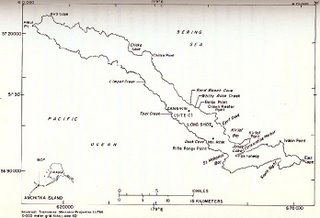Conservation efforts on Amchitka Island
 < map of Amchitka Island
< map of Amchitka IslandAmchitka Island is an uninhabited island about 1,400 miles southwest of Anchorage , Alaska. This Aleutian Island is home to an abundance of sea life. Alongside the island are fish-affluent waters that support some of the world’s largest commercial seafood companies. Deep beneath the waters of Amchitka Island, which is now part of the Alaska Maritime National Wildlife Refuge, are three bomb-carved cavities that are filled with radioactive waste.
The Atomic Energy Commission discharged three bombs between 1965 and 1971. This was the last underground U.S. nuclear-weapon test. The final and the most powerful bomb was the five-megaton Cannikin blast in 1971. This bomb was almost 400 times as powerful as the one that destroyed Hiroshima. The fulmination of the Cannikin was equivalent to a magnitude 7 earthquake and killed thousands of sea otters. These nuclear-weapon tests angered politicians and environmentalists alike. The tests sparked the creation of Greenpeace, an environmental group. People were frustrated over the secrecy of the scientists, which in turn spurred the creation of the Freedom of Information Act.
Decades later, there is still worry about radioactive leakage, especially because Amchitka is now the site of a marine refuge. The waste pits and the drill holes made by the blasts are covered with a multilayered mat that’s in turn topped with new vegetation. Peter Sanders, a Department of Energy project manager, says, “If you didn’t know what you were looking for, you wouldn’t know what had happened out there.”
Under the new Legacy Management program, Amchitka Island will be monitored quinquennially, to see if any radioactive waste has leaked. After a five-year environmental restoration program, the Department of Energy determined that there has been no evidence of radioactive waste contaminating the food chain of the marine life. However, there has been a different effect on many of the people who once worked on Amchitka Island . Some have high rates of various types of cancer, according to medical studies.
Amchitka Island is a former site of nuclear-weapons testing that is now being used as a marine wildlife refuge. Los Alamos , New Mexico is also a former site of nuclear-weapons creation and testing. However, the buildings themselves are going to be preserved, instead of wildlife. Though slightly different, the two events are definite parallels to each other.
Preservationists have skirted around security barriers to conserve a building in which the Manhattan Project scientists did their work at the Los Alamos National Laboratory. The Manhattan Project refers to the effort to develop the first nuclear weapons during World War II by the United States. Preservationists say that the building is as significant as a Civil War battlefield or as George Washington’s home.
A wooden, garage-like building is the site where the world’s first plutonium bombs were assembled. This plain and uncomplicated structure serves as a reminder of the urgency with which scientists gathered to assemble and design the first atomic weapons. McAllister Hull, who was a 21-year-old Army sergeant back in the 1940s, recalled working in a casting building on the site. Hull ’s job was to supervise crews that were casting explosive lenses that would direct pressure to compress a plutonium core in “the gadget.” “The gadget” was the prototype of the “Fat Man” bomb. This gadget was put together at the “high bay” building, one of the buildings on site.
The bomb was fully assembled and discharged at the Trinity Site, 200 miles south of Los Alamos , in July of 1945. A similar bomb was dropped on Nagasaki less than a month later, and three days after a uranium-based bomb was dropped on Hiroshima . The “high bay” building is said to cost about $1 million to restore and is currently inaccessible to the public. However, weekend events include a reception and dinner, bus tours, and a conference featuring artists and writers.
Greg Mello, anti-nuclear activist, ‘objects to the celebratory aura’ surrounding the events. Mello protests that the events should have a more somber tone because they commemorate work that led to the bombing of two Japanese cities. Several other sites at Los Alamos besides the “high bay” building are also going to be preserved.

0 Comments:
Post a Comment
<< Home